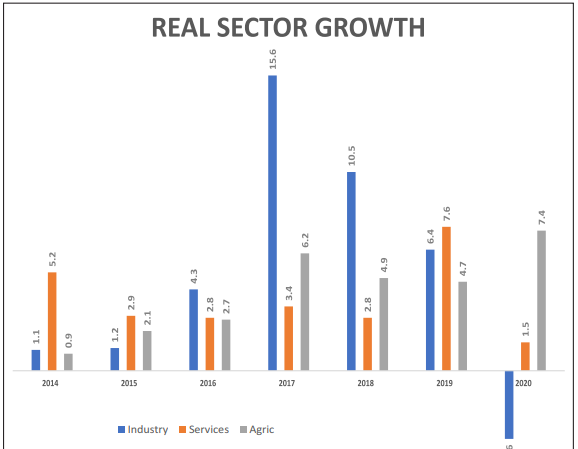…as it contracts while agric and services grow
While both the agriculture and services sectors were able to post growth in 2020, albeit slower – especially for the latter, the industrial base of the economy couldn’t withstand the storm; hence, experiencing its poorest performance in six years.
Figures published by the Ghana Statistical Service (GSS) show that the second-largest contributor to the economy, industry, recorded a 3.6 percent contraction in the pandemic year – a sharp nose-dive from the 6.4 percent growth recorded the previous year, and the worst performance ever since the GDP figures were rebased in 2014.
The services sector – which has been the main driver of growth for the country in many years, and also the largest sector – also saw its slowest growth since 2014, recording 1.5 percent as against 7.6 percent in 2019. Then, agriculture – the sector often neglected by both government and the financial sector – pulled a surprise by growing at an impressive rate of 7.4 percent; the best it has ever seen since the rebasing year.
This indicates that with exception of the agriculture sector, the pandemic took a very deep bite of services and industry – with the latter getting the severest crack in the bone. It is further observed in the report that what really sank industry was the extractive industries, as the mining and quarrying sector saw an 11 percent contraction – of which oil and gas sector’s contribution was -9 percent.
This comes as no surprise, as the pandemic, together with a price-war between Russia and Saudi Arabia forced Brent crude prices to tumble below US$20 per barrel at some point in April 2020.
Prof. Quartey upbeat it will surmount challenges
Commenting on this, Director of the Institute of Social, Statistical and Economic Research (ISSER) at the University of Ghana, Professor Peter Quartey, also underscored the fact development in the oil and gas, mining, and construction sectors all contributed to the contraction of industry in 2020.
“Oil and gas, and mining are part of industrial sector, and COVID-19 affected them so much. If you look at the mining companies, quite a number of them were not able to operate at full capacity. In fact, some of the engineers had to even go back to their countries and so mining activities slowed down. And then, with oil and gas, demand itself did not pick up as much as it should so prices were affected, and this affected total revenue from oil.
“A lot of construction activities were halted because government had to channel resources into fighting the pandemic. Most of the contractors couldn’t get loans to undertake their activities, and neither were they paid by government too. So, I believe all of these together worked toward the decline of industry,” he said in an interview with the B&FT.
However, the professor was upbeat that with the resumption of economic activities, if the right structures and policies are put in place by government in the recovery process, industry will not suffer the same ill fate again but rather get back to the path of growth.
“The mining sector is back working, and it is likely that growth will pick up in the course of the year. All the engineers who went back to their countries are back; and some of them have had their vaccines already, so they are back to work.
“And from the 2021 budget, if government is also able to raise the needed revenue and the Year of Roads project picks up, the construction sector will also pick up. But it won’t be by a large margin, because the recovery is a gradual process
“The role of credit is also very critical and important. Government must also ensure that, through the banking system, interest rates are reduced for manufacturing and other activities. Then, the cost of doing business must also be affordable – especially the cost of electricity and water. They will play a critical role in recovery of the sector going forward,” he said.










